Chinese sculpture at the Art Institute
Here's a compilation of my favorite items from the genres on permanent display at the Art Institute. Some of these things are in the place where I saw them on my first visit -- about 40 years ago -- but some are more recent - and I've painfully learned that nothing is on permanent display. So I thought I'd take a moment to document what I like the most.

This Tang Boddisatva is my favorite piece in the museum -- and given it's prominent location -- I don't think I'm alone in my admiration for it.
 Front view of the same sculpture (taken with my new "image stabilized" camera)
Front view of the same sculpture (taken with my new "image stabilized" camera)
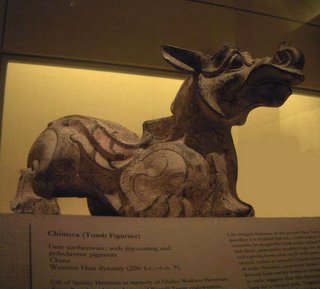
Cute little doggie, isn't he ? Found in a Han tomb - but it seems like it would also work as a roof-top decoration.

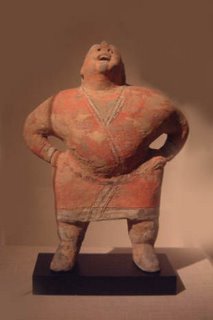
This jovial fellow was found in a 6th C. AD tomb -- thought to be an entertainer.
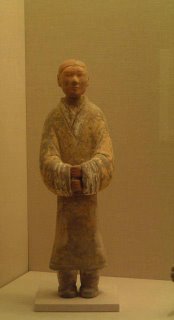
A Han dynasty tomb figure - with an especially thoughtful expression, don't you think ?
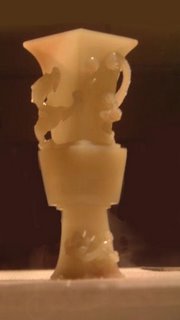
I'm not a big fan of jade -- I think it's so hard to work, the issue of design is
made secondary. But this Ming era chalice with dragons is one of the nicer pieces. Can you imagine actually sipping from it ?
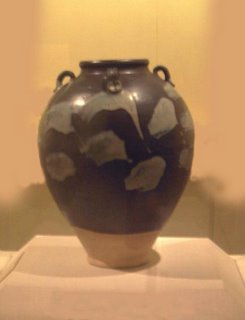
This is my favorite Tang vase in the collection -- those white splotches are more than just splotches -- they're alive -- like an airborn flock of geese.
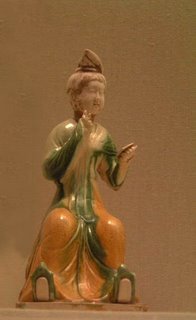

These delightful, rainbow-colored girls have always pulled me into their private little boudoirs. They're about the right age for the pavillions in "Dream of Red Chamber", but they lived 1,000 years earlier.

For whatever reason, China doesn't seem to have portrait sculpture of ancestors --
I'm guessing that's because the power of the head-of-family is so absolute, everyone is relieved when he's finally gone. But monastaries are the exception - where maybe those lonely guys really did miss those who have died. This is an 11th Century
piece -- hollow with a lacquer surface.
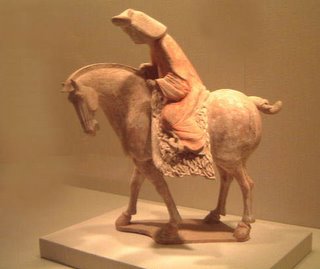
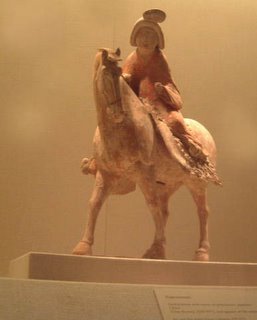
Another one of my 40-year favorites - see how even an unusual vantage point offers a delightful view. So soft -- so gentle -- so stately -- the happy, idyllic world
of Tang. Why couldn't it last forever ?
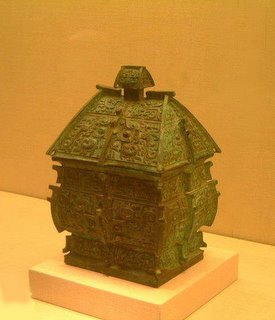
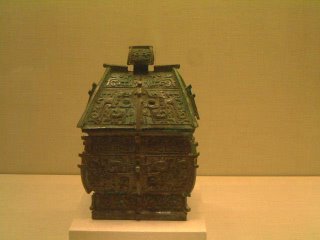
I've never been able to imagine myself in a social event that would use these architectural wine jars from the Zhou dynasty (1050 - 770 BC )


They have whimsy and power, don't they ? As if they contained something more important than wine. They seem to belong in a room into which no one is allowed to enter.

This Tang Boddisatva is my favorite piece in the museum -- and given it's prominent location -- I don't think I'm alone in my admiration for it.
 Front view of the same sculpture (taken with my new "image stabilized" camera)
Front view of the same sculpture (taken with my new "image stabilized" camera)
Cute little doggie, isn't he ? Found in a Han tomb - but it seems like it would also work as a roof-top decoration.


This jovial fellow was found in a 6th C. AD tomb -- thought to be an entertainer.

A Han dynasty tomb figure - with an especially thoughtful expression, don't you think ?

I'm not a big fan of jade -- I think it's so hard to work, the issue of design is
made secondary. But this Ming era chalice with dragons is one of the nicer pieces. Can you imagine actually sipping from it ?

This is my favorite Tang vase in the collection -- those white splotches are more than just splotches -- they're alive -- like an airborn flock of geese.


These delightful, rainbow-colored girls have always pulled me into their private little boudoirs. They're about the right age for the pavillions in "Dream of Red Chamber", but they lived 1,000 years earlier.

For whatever reason, China doesn't seem to have portrait sculpture of ancestors --
I'm guessing that's because the power of the head-of-family is so absolute, everyone is relieved when he's finally gone. But monastaries are the exception - where maybe those lonely guys really did miss those who have died. This is an 11th Century
piece -- hollow with a lacquer surface.


Another one of my 40-year favorites - see how even an unusual vantage point offers a delightful view. So soft -- so gentle -- so stately -- the happy, idyllic world
of Tang. Why couldn't it last forever ?


I've never been able to imagine myself in a social event that would use these architectural wine jars from the Zhou dynasty (1050 - 770 BC )


They have whimsy and power, don't they ? As if they contained something more important than wine. They seem to belong in a room into which no one is allowed to enter.


10 Comments:
I like the guy on the horse the best.
One of my favorite shows ever was the Chinese Exhibition in London—1974? eons ago—those shy-necked horses, the jade plates stitched with gold thread, tomb soldiers, joyous leopards (I think it was leopards.) These things have great charm, and I don’t know about the architectural jars; perhaps you and your e-friend Gawain could get some very long and silly (polka-dotted, twisted, decorated with those little slip-on animals--say, tiny Giant Pandas) straws and sip wine together, under the trees of Mount Shang.
Yes - I see it now -- Sir Gawain and I -- dressed in Chinese silks -- sipping wine from those impossibly ornamented jars -- with pink silly straws, hats, and other accessories from a children's birthday party. (and you're invited as well -- indeed, we're expecting you to bring the straws and hats)
I think the London exhibit that you saw was from the excavation of the Chin emperor's tomb -- most of which the wisely cautious Chinese archeologists have still left untouched. Can you imagine all the wonders that are still down there ?
Fooh!
Blogspot ate my note--sent me to Error Message Hell.
What was I saying?
At my house, we are very big on funny hats and have many in the dress-up box. My daughter went to school yesterday in an astonishing dress-up box outfit--up-ended the natives, astounded the teachers.
Yes, it would be very lovely to be the first to shine a wavering beam of light into the dark.
I was reading translations of poems by Tang women today--and hit on a line with "rainbow silks" to describe the skirts. And thought of your "rainbow-colored" girls.
So I came back to visit them.
What search engine do you use for images? I was thinking about your Rosner hunt and wondering whether those specialty engines are any better that Google.
Marly, could you post one of the poems that mentions the rainbow silks ? I'm fascinated !
(regarding search engines for artists -- I probably need some help -- because all I've been using is Google)
I've written a post about the book I've been reading--will put it up in the next week some time. Here's a poem with "rainbow" girls:
Springtime Views in the Land of Qin
Lovely, these views of spring
from up in the Phoenix Tower:
guard posts at palace gates,
walls within walls within walls,
and in His Majesty's garden
trees in the falling rain--
or peaks of the seekers' range
after the skies turn clear.
Wherever you walk, flowers
fallen--everywhere,
and palpable, favorable airs,
drenched, when evening comes.
Look with joy on this blessed,
on this radiant age,
as skirts of rainbow silks
take the path of the Taoist Way.
That's one of the poems I wrote about, too, I think. It's by Yuan Chun and translated by Jeanne Larsen.
How exciting ! The Tower reminds me of the one built by the great genius-villain-warlord -- of "Romance of Three Kingdoms" whose greatest ambition in life was to obtain the world's most beautiful woman and install her in a magnificent tower built to his specification. (story based on history of 2nd Century -- and fictionalized about 900 years later)
Does Jeanne Larson say anything more about Yuan Chun ? Unfortunately, that's the name also given to the Imperial Concubine in "Red Chamber", so that's all Google can find.
I wish we could have our Chinese friends look at the original text.
I'm curious about how the translator came up with the last line "Take the path of the Taoist Way" (since "tao" means "way" -- as in "the way birds fly" -- the "way the seasons change" etc -- so I question where there would have been a specific reference to the cult of Taoism -- as this translation seems to imply)
You know, I can't quite tell from the notes, but the poem seems to actually invoke the Tao with more specificity.
From the notes:
"Although they wear gowns suggesting romantic love, the harem women devote themselves not to the transitory pleasures of spring, but to Taoist teachings. Is this fact or wish or some of each?"
Maybe I'll ask Jeanne... Here's what she says about the poet:
"Yuan Chun (fl. before 875) a 'Female Scholar of the Tao,' was evidently summoned to the Tang court from her home in Luoyang, in north central China. Fragments of lost poems by Yuan bear titles indicating literary exchanges with other women."
Got an interesting response from Jeanne, and I'm going to ask if I can use it (she's away right now.) Maybe I'll post it Monday or Tuesday, along with some poems and thoughts.
Post a Comment
<< Home